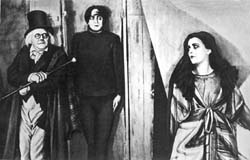Kyiv hosts small German Cinema of the 1920s Festival

Happy are those people who have experienced cinematography since their birth. No matter what turn history might later take, the muse of the silver screen favors the cinematographic nation, inspiring ever new generations of film directors and script writers. Germany is one of the chosen countries that has powerfully and convincingly embodied itself in motion pictures. Logically, the three-day festival of German Cinema of the 1920s, held in Kyiv’s House of Cinematographers, became a notable cultural event.
The point is not that the films shown belonged to the golden age of the German cinema. The organizer, Kyiv’s Goethe Institute, constructed the festival scenario as a multistage show, with some of the old cast addressing the audience and an exhibit, Fritz Lang: Images and Prototypes, in the lobby. The advantage of the current retrospective, compared to last year’s nonetheless successful one, was that this time one was aware of the context as being contemporary to the old movies. The visual fairy tale of the epoch of German impressionism begot screen images just as whimsical, as evidenced by the exhibit, and was traced in music. The accompaniment of silent movies with such freakish symbolism and dramatic composition, of course, reached far above the standard. Small wonder that in Kyiv the accompaniment was done by noted performing groups such as the Kyiv Chamber Soloists conducted by Frank Strobel from Berlin, Nova Rich [New Thing], and electronic instrumentalist Oleksandr Nesterov. In fact, the accompanists’ appearance was an event in itself. Combined with first-rate films, the whole thing was a real audio-video spectacle, but of course, the films were the key element.
Five films were shown, made by different directors, representing different genres, even technique. It was hard to give preference to any, for practically every production was a masterpiece in terms of creative work and message to the audience, as each such message sounds relevant even now, eighty years later. Most dened with the heritage of the image-bearing language; they were creating it. This captivating primordial character fills every scene even in the relatively simple entertaining Georg Wilhelm Pabst’s Der Schatz (The Treasure, 1923) that opened the program. A trivial melodrama with a moralizing finale, yet impressing one with a detailed approach to every scene, setting composition, with all tangible objects becoming a more expressive and contrasting background to the unfolding passions. Actually, there was apparently no opposition between entertainment and the author’s quest at the time. Lotta Reininger with her Adventures of Prince Ahmad seems to have wanted to entertain the audience of the 1920s in the first place, as things Oriental were popular at the time, like the shadow theater or Arabian Nights. She worked on the film for three years and cut over 100,000 paper silhouettes, and animated them on screen. The result was an unmatched animated cartoon, the refined artwork striking even now in the age of computers.
The Cabinet of Dr. Caligari, a renowned production (a new copy was shown at the festival), is also considered a classic horror film, a quintessence of expressionism from the early twentieth century. Although the horror part should rather be described in terms of consequences for the world genre cinema, Robert Wiene’s creative discoveries would subsequently inspire horror movie authors. Today, of course, Dr. Caligari is purely a style specimen. The picture’s contorted realities, the mentally deranged hero’s visions are strikingly gripping indeed, and the audience is kept in suspense from the very first scene.
Fritz Lang, all-time genius of the German cinema, suffered from unrestrained quoting and perhaps even more so from plagiarism. There is not a single production he made — during the postwar period at any rate — which was not stolen, literally frame by frame, by film-directors, clip makers, photographers or artists. Among such much- quoted pictures is Der mude Tod (Weary Death, 1921, released in death, life, and making a choice among them occupied the central place on the festival program. And the accompaniment played an important role. The score was written specially for the film by Oleksandr Kokhanovsky and Danylo Pertsev. Performed by the Nova Rich, it did not impose on the composers’ vision of the movie but stressed its rhythm and mood, lending it special overtones, sharpening the audience’s perception.
Finally, Lang’s first sound film M (1931), a psychological thriller about a compulsive murderer, came as a surprise for many Kyiv moviegoers. The plot is quite trivial today: a child murderer. Apart from the fact that Lang was the first to broach the subject, the detective story was actually used for things outwardly totally unnecessary for a thriller. More than enough aggravating circumstances; refined burlesque drawing parallels between the underworld and the cream of society; multiple cameraman’s innovations close-up on detail in every frame verging on obsession: and painstaking dramatization of every character, including the inimitable main hero, a serial killer, a maniac with a round boyish face. As a thriller, the film falls flat, but that is not necessary. The notions of horror and vice have changed on the screen, yet Lang’s M will be watched with unflagging interest, regardless of what kind of horrors or euphoria are in vague.
Historical definitions are actually no good for the festival’s movies. It is not a digression into the cinematic past. Rather, it is five testimonies to the creative work done by masters who would soon be rejected and cursed by their fatherland gone insane. However, having once captured their homeland on film, they left it a chance for the future; to use it: Germany had just to heed to its once anathematized poets. And justice triumphed in the end. The strange angular dreams of Lang, Reininger, Wiene, and Pabst have long departed from their epoch and their country; now times and peoples flow through these scratched films, always emerging amazed.






